A step-by-step guide to growing leeks from seeds for beginner gardeners
The demand for leeks increases every year. The plant has a piquant taste and is rich in nutrients. A distinctive feature of the vegetable is its ability to grow in regions with difficult climates. All the secrets and features of breeding this crop are collected in our article.
Features of growing leeks from seeds
Leeks are a biennial herbaceous crop that can be grown:
- In a seedless way. Seeds are planted in open ground, a greenhouse or greenhouse.
- By seedling method. Seedlings are grown from seeds, which are then transplanted into the soil.
When choosing a planting method, you need to take into account the climatic conditions of the region. Seeds are planted in open ground only in the southern regions of the country. In this case, the soil should warm up well. In regions with changeable weather conditions, the seedling method is used. Depending on the climate, the plant variety is chosen.
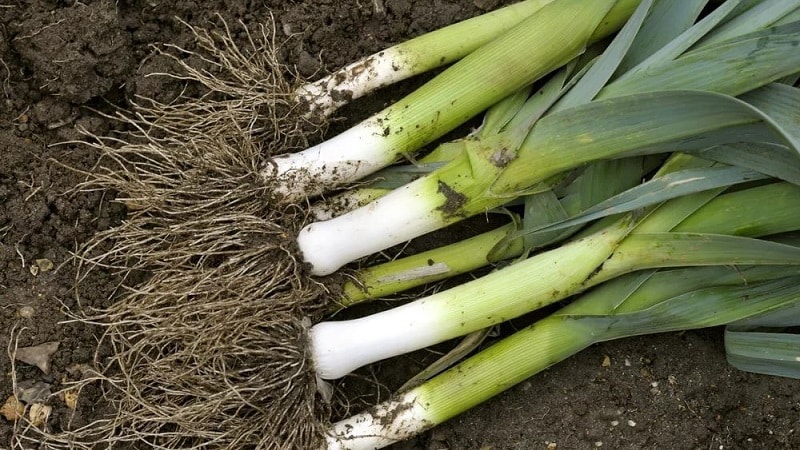
Preparatory stage
Half of the harvest volume depends on the correct preparatory stage.. It includes selection and hardening of seeds, preparation of suitable soil and containers for seedlings.
Seed preparation
High-quality planting material and proper care will ensure a good harvest. Seeds are prepared for planting - hardened and disinfected.
Procedure:
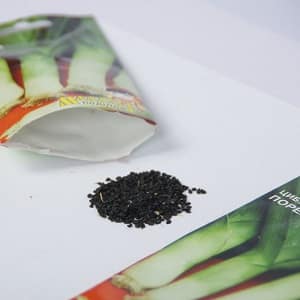 Boil water and cool it to a temperature of +40...+45°C.
Boil water and cool it to a temperature of +40...+45°C.- Place the seeds in a gauze bag and soak in hot water for 25 minutes.
- Rinse the seeds with cool water and place them on a damp cloth.
- Cover the top with a small piece of cloth and leave for 3-5 days.
- During this time, periodically spray the fabric with water from a spray bottle.
- If desired, the seeds can be disinfected in a weak solution of potassium permanganate.
If you bought seeds, you do not need to disinfect them. This is only necessary for self-collected material.
Important! The shelf life of seeds is 2-3 years. With each subsequent year, germination rate decreases.
Preparing soil and containers
Leeks are unpretentious to the soil. The best option is fertile sandy-clayey soil.. Peat humus pots, which are produced specifically for growing seedlings, are also suitable. After treatment, the seeds are planted in pre-prepared containers with a depth of 12 cm.
Attention! The prepared container should be treated with a disinfectant.
Instructions for growing leeks from seeds in one season
In most regions of Russia the climate is unpredictable, so It is better to plant leeks in open ground as mature seedlings. This method will allow you to consume the vegetable at the end of the summer season. The ripening period of onions is 7-8 months.
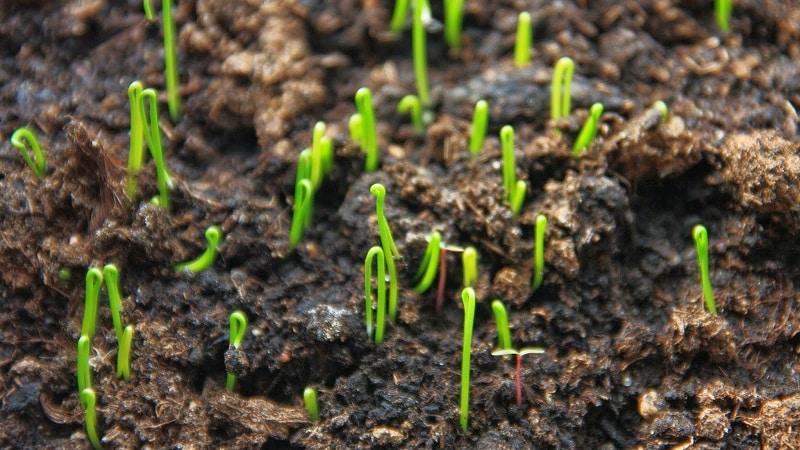
Planting seedlings and caring for them
Growing seedlings start training from the end of February in warmer regions or from mid-March in colder regions. It is necessary to prepare the soil: it must contain organic (wood ash, turf, peat) and inorganic (urea, compost, superphosphate) fertilizers.
Important! Heavy clay soil is not suitable for the plant.
Algorithm of actions:
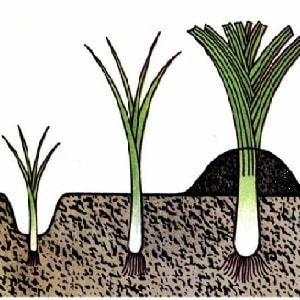 Mix the soil with fertilizer and moisten it slightly.
Mix the soil with fertilizer and moisten it slightly.- Place the soil in a box and compact it. There should be no voids - they prevent plants from taking root.
- Make grooves in the soil no more than 2 cm deep.
- Place seeds in them and sprinkle a little sand on top.
- Spray the soil with a spray bottle and cover with film.
- The room temperature should be within +20°C.
- With the emergence of seedlings, the seedlings need to be hardened off. To do this, move the box to a cool place.
- Remove the film and reduce the room temperature by 1°C daily.
- Complete hardening at a temperature of +14°C.
With proper care, the first shoots will appear in 7-14 days, if incorrect - after 20. Seedlings require 12 hours of daylight. To ensure this, stock up on additional light sources. Onions need plenty of watering, do not allow them to dry out. A month after germination, thin out the leeks: leave a distance between sprouts of 3-4 cm. The height of the seedlings should not exceed 10 cm, so trim them. Fertilize the sprouts 2 weeks after germination and a week before planting in the ground.
Interesting things on the site:
Landing in the ground
The main condition is the absence of sudden temperature changes. The best option is to maintain the temperature at least +18°C during the day and at least +13°C in the evening. Failure to comply with the conditions will lead to plant disease and they will not be able to take root.
Reference. Many people classify leeks as cold-resistant plants, but this does not apply to seedlings. It should only be planted in warm soil without the threat of frost.
Before transplanting into open ground, select acceptable conditions for onions. The beds should be in a bright, open place. You can plant leeks where tomatoes, potatoes, and eggplants used to grow. Before planting, moisten the soil and trim the roots and leaves of the seedlings.
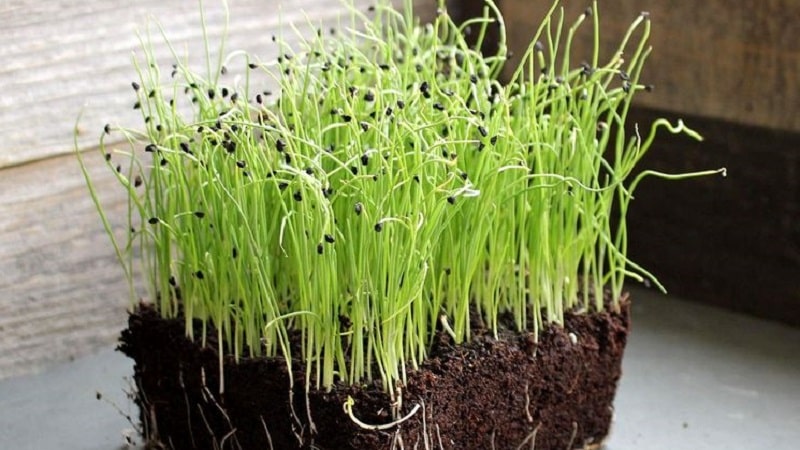
Leek seedlings are deepened into the soil by 6-7 cm. The distance in a row between sprouts is 12-15 cm, the width between the beds is 30-50 cm. Do not plant the bulbs close to each other - this results in poor development of the white part of the stem. Onions need enough space to take root well.
Care
Experienced gardeners note that for successful cultivation of leeks It is enough to follow three rules of care:
- Regular watering. The vegetable loves moisture. He needs it for growth and development. Water the plant once every 4-6 days. To retain moisture, use mulching - cover the beds with straw or peat. But make sure there is no excess water. This can cause illness.
- Timely feeding. Vegetable crops need nutrients. Do not forget to feed the soil using compounds with ammonium nitrate, mullein, and wood ash.
- Hilling and weed control. Loosen the soil and remove all weeds. Hill up seedlings 4-5 times per season.
Diseases and pests
Like any plant, leeks are susceptible to diseases and pest attacks.
Common diseases:
- powdery mildew is a fungus that appears as a greenish coating on the leaves and stem;
- bacterial stripe spot and rot - watery spots appear on the leaves, the tips turn brown, stripes appear on them, first green and then black, the leaves curl;
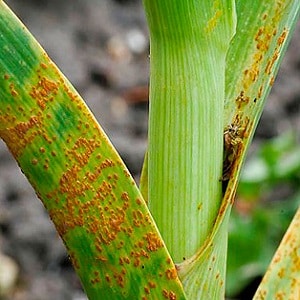 core rot - white or brown spots on the inner leaves, their death;
core rot - white or brown spots on the inner leaves, their death;- bottom rot - curling and necrosis of leaves, thickened, transparent roots, brown watery spot on the bottom;
- onion rust (pictured) - rapid spread of painful red spots throughout the plant.
Dangerous pests include:
- onion moth - leaves turn yellow at the ends and dry out;
- hoverfly - the larvae leave long stripes on the leaves;
- root mite - the leaves become deformed and become covered with a whitish coating;
- secretive proboscis - leaves become deformed and dry out;
- nematode – plants are stunted, brown lesions are visible on thin roots;
- thrips - growth slows down, leaves turn yellow.
Gardeners fight diseases and pests immediately. To treat diseases, the drugs “Quadris”, “Acrobat”, “Signum” are used, and to get rid of pests - “Connect”, “Vantex”.
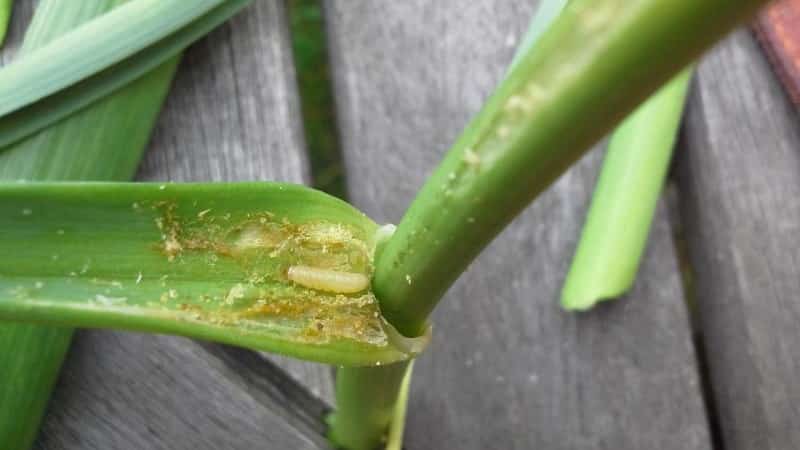
Harvest and storage
Harvest time depends on the plant variety. Early ripening varieties are harvested in July, later ones - in October. Leeks are dug up with wide forks, and they are immersed in the soil at a distance of 15 cm from the plant - this makes it more convenient to remove the vegetable from the ground.
Onions are stored in different ways:
- In a pantry, basement, refrigerator, where the air temperature is no more than +1...+2°C. In such conditions, onions can last up to 3-4 months.
- In a box of sand. Cover the white part of the stem with sand and put the box in a cool place.
- In the hole. The leeks are placed in a dug hole and covered with earth. In cold weather, dry leaves are placed on top.
- Frozen. The vegetable is washed, dried, cut and placed in portions in the freezer.
- In a dried state. The onion is washed, dried, cut and left for several days at room temperature. When dry, it is stored hermetically sealed.
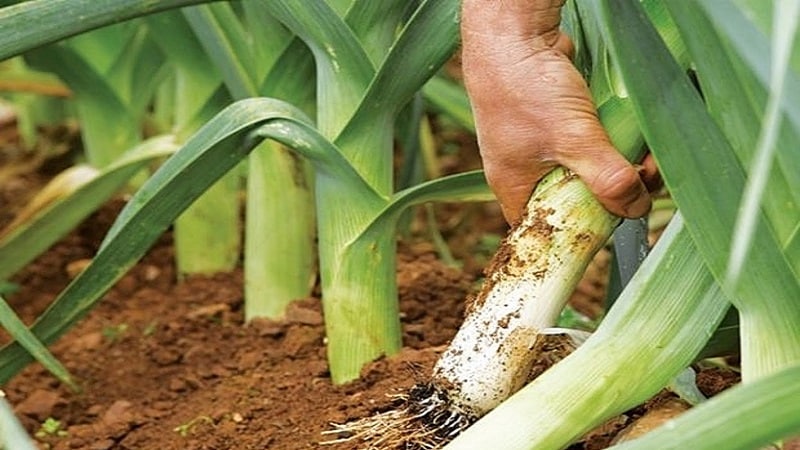
How to grow leek seeds
In order not to buy seeds for next year, you can collect planting material yourself. To do this, you need to leave a few bulbs in the ground. After wintering, the plant will shoot and begin to bloom. After flowering, seed pods are formed that will produce seeds.
If this option is not suitable, use the following recommendations:
- In the spring, bury the best bulbs in the greenhouse.
- Once the plants produce feathers, do not trim them.
- The bow will shoot arrows on which seed pods will form.
Take note:
Advice from experienced gardeners
Advice from experienced summer residents who know nuances of growing leeks:
- Be careful when choosing fertilizers. Leeks do not like nitrogen fertilizers, limit their use.
- Don't neglect mulching the soil. It retains moisture in the required volume and prevents dehydration of the plant.
- Weeds harm the ripening of onions. Destroy weeds in a timely manner and loosen the soil.
- Leek is a moisture-loving plant. Provide it with timely watering.
Conclusion
Growing leeks requires a little knowledge and effort. Choose quality seeds for your climate, water and fertilize the soil abundantly, and repel pests. This will allow you to reap a large harvest and enjoy the healthy vegetable.
How to understand this?
“Vegetable crops need nutrients. Don’t forget to feed the soil using compounds with ammonium nitrate."
And
“Leeks do not like nitrogen fertilizing”